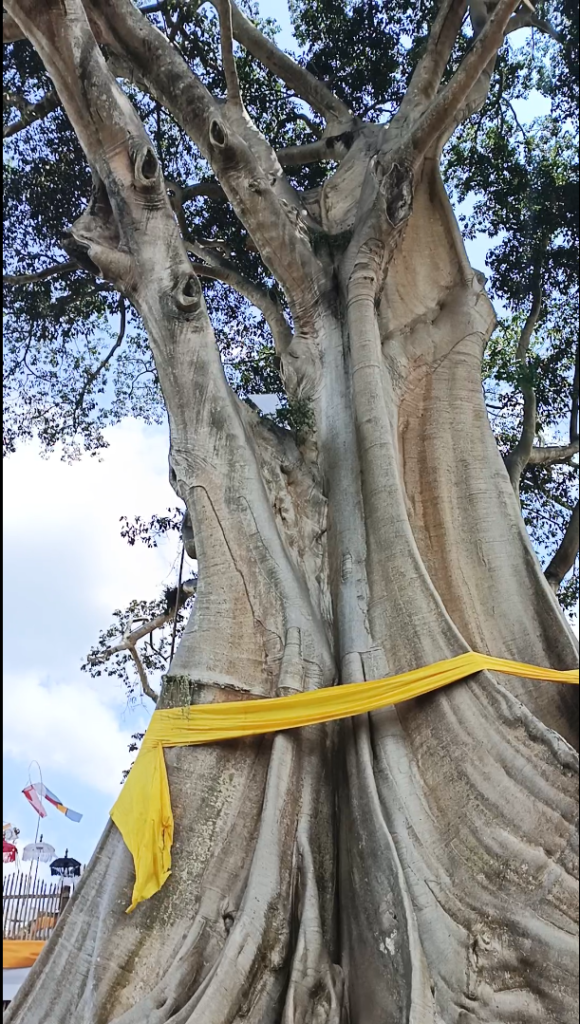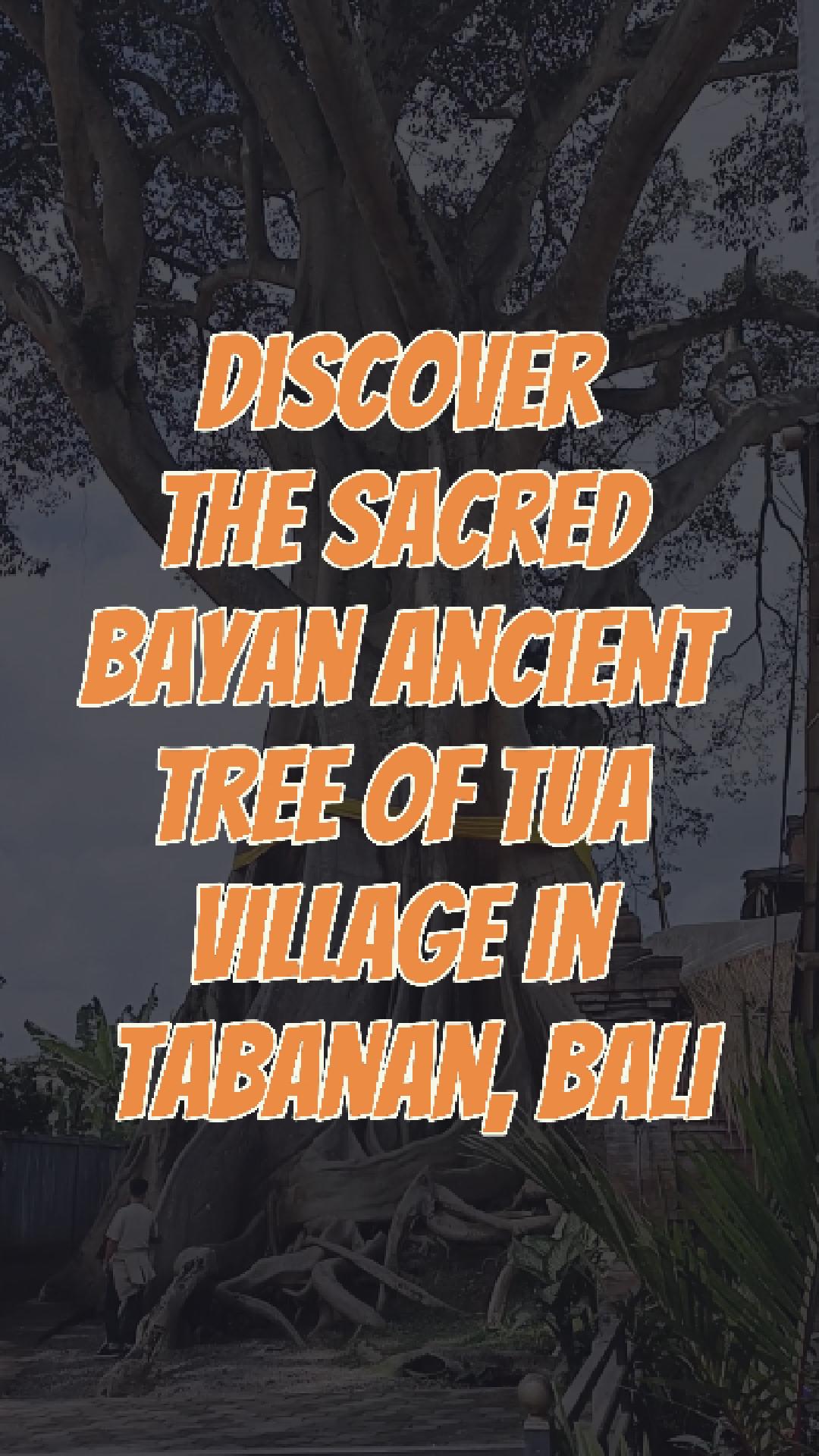Table of Contents
ToggleIntroduction to the Banyan Ancient Tree
In the heart of Bali, nestled within the lush greenery of Tua Village in Marga, stands a true natural marvel: a 700-year-old banyan tree. Known for its remarkable size and deep cultural significance, this ancient tree has become a beloved landmark for locals and visitors alike. Its towering presence and sprawling roots speak of centuries past, bearing witness to Bali’s rich history and heritage.
Location and Accessibility
Exact Location: Tua Village in Marga
The Banyan Ancient Tree is located in Tua Village within the Marga district of Bali’s Tabanan Regency. This location, surrounded by rice fields and quiet villages, offers a peaceful atmosphere that perfectly complements the sacred aura of the tree. Being away from the more tourist-heavy areas of Bali, it provides a unique and tranquil experience for visitors.
How to Get There
Visitors can reach Tua Village easily by car or scooter, with the journey from major tourist areas like Ubud or Seminyak taking around an hour. Local guides or transportation services can also assist in finding this tucked-away gem, which may be challenging to locate without a local’s help.
The Cultural Significance of Banyan Trees
Symbolism in Balinese Culture
In Balinese culture, banyan trees are considered sacred and are often associated with protection and shelter. Known locally as “waringin” or “pohon beringin,” banyan trees are believed to embody divine energy, making them common sites for offerings, ceremonies, and spiritual gatherings.
Role in Spirituality and Local Traditions
The Banyan Ancient Tree in Tua Village isn’t just a natural attraction; it’s a spiritual one. Locals frequently use this tree as a space for prayer and ritual, believing it connects them with their ancestors and the spiritual realm. Many Balinese temples are situated near banyan trees, reflecting the belief that these trees are homes to spirits and protectors of the land.
The History and Age of the Banyan Tree
Estimating Its Age
Estimating the exact age of a banyan tree is challenging due to the complex structure of its trunk and roots. However, local knowledge and historical records suggest that the Banyan Ancient Tree of Tua Village is at least 700 years old, making it one of Bali’s oldest living monuments.
Historical Importance to Bali
This tree has witnessed countless cultural and historical events in Bali, from traditional ceremonies to the evolution of local traditions. Its longevity serves as a reminder of the island’s ancient roots and enduring connection to the natural world, with each layer of bark and every twist of its roots telling a story of resilience.
The Tree’s Mystical Appearance

The Roots and Trunk Structure
One of the most fascinating aspects of the Banyan Ancient Tree is its massive, intricate root system. The roots twist and weave in a mesmerizing pattern, forming natural arches and hollows. These roots create a sense of mystery, inviting visitors to explore the hidden corners of this living giant.
Branches and Canopy Size
The canopy of the tree spreads wide, creating an expansive, shaded area underneath. It feels almost like stepping into another world beneath the leaves, where sunlight filters through, casting dappled light on the ground below. The canopy’s sheer size is a testament to the tree’s age and its powerful presence in Tua Village.
Environmental Impact
A Haven for Wildlife
The Banyan Ancient Tree is more than just a cultural landmark; it’s also an ecosystem. Birds, insects, and small mammals find shelter within its branches and roots, making it a vital part of the local biodiversity. Observing the wildlife here is another reason to visit, as you may spot creatures that rely on this tree for survival.
Role in Biodiversity
Large banyan trees like this one play an essential role in supporting biodiversity, as their sprawling structure provides various micro-habitats. They contribute to the balance of local ecosystems, offering food and shelter for many species.
Visiting the Banyan Tree
Things to See and Do
Beyond admiring the tree itself, visitors can experience traditional offerings and ceremonies, gaining a glimpse into the Balinese spiritual connection with nature. For photography enthusiasts, the tree’s dramatic roots and branches make for fantastic, one-of-a-kind shots.
Nearby Attractions
In addition to the Banyan Ancient Tree, Tabanan Regency is home to other beautiful sites. Nearby, you’ll find Jatiluwih Rice Terraces, which are UNESCO-listed, and the scenic Pura Luhur Batukaru temple, both of which are worth visiting for a full cultural experience in Bali.
Tips for Respectful Visits
Customs and Etiquette
When visiting a culturally significant site like the Banyan Ancient Tree, it’s essential to observe local customs. Dress modestly, as Balinese culture values respect for nature and spirituality. Wearing a sarong and sash can help show your appreciation for local traditions.
Dos and Don’ts
Do: Offer a small prayer or respectful gesture before approaching the tree, as locals may perform blessings or offerings here.
Don’t: Touch or disturb the tree’s roots, branches, or any ceremonial items left by the locals. These offerings are sacred, and respecting them ensures you honor the traditions.
Conclusion
The Banyan Ancient Tree in Tua Village, Marga, Bali, is much more than a natural wonder. Its roots run deep into Bali’s history, culture, and spirituality, standing as a testament to the enduring relationship between the Balinese people and nature. This 700-year-old tree invites visitors to step into a world where time slows down, nature reigns supreme, and tradition lives on in every leaf and branch. Visiting this remarkable tree offers not only a glimpse into Bali’s natural beauty but also a deeper understanding of the culture that treasures and preserves it.
FAQs
Q1: What makes the Banyan Ancient Tree in Bali unique?
A: Its age, size, and cultural significance make it unique. Estimated to be over 700 years old, it’s a sacred tree deeply rooted in Balinese spirituality.
Q2: How can I visit the Banyan Ancient Tree?
A: The tree is located in Tua Village, Marga, in Tabanan Regency. You can reach it by car or scooter from Ubud, Seminyak, or other nearby areas.
Q3: Are there any specific customs to follow when visiting?
A: Yes, visitors should dress modestly, avoid touching offerings, and show respect by following local customs and traditions.
Q4: What other attractions are near the Banyan Ancient Tree?
A: Nearby attractions include the Jatiluwih Rice Terraces and Pura Luhur Batukaru temple, which are also culturally significant.
Q5: Can I take photos at the Banyan Ancient Tree?
A: Yes, photography is allowed, but be mindful not to disturb any offerings or interfere with local practices.



